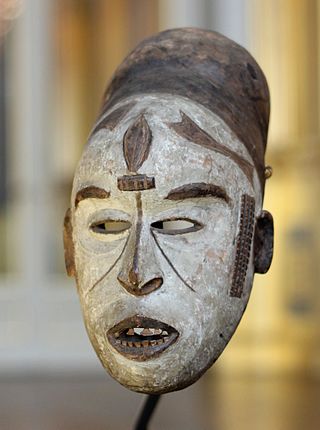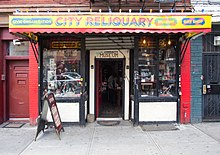
The Metropolitan Museum of Art, colloquially referred to as the Met, is an encyclopedic art museum in New York City. By floor area, it is the fourth-largest museum in the world and the largest art museum in the Americas. With 5.36 million visitors in 2023, it is the most-visited museum in the United States and the fourth-most visited art museum in the world.

A museum is an institution dedicated to displaying and/or preserving culturally or scientifically significant objects. Many museums have exhibitions of these objects on public display, and some have private collections that are used by researchers and specialists. Museums host a much wider range of objects than a library, and usually focus on a specific theme, such as the arts, science, natural history or local history. Public museums that host exhibitions and interactive demonstrations are often tourist attractions, and many attract large numbers of visitors from outside their host country, with the most visited museums in the world attracting millions of visitors annually.

Brooklyn is a borough of New York City located at the westernmost end of Long Island in the State of New York. Formerly an independent city, the borough is coextensive with Kings County, one of twelve original counties established under British rule in 1683 in the newly formed Province of New York upon seizing the colony of New Netherland from the Dutch. As of the 2020 United States census, the population stood at 2,736,074, making it the most populous of the five boroughs of New York City, the most populous county in the State of New York, and the ninth most populous county in the United States. In 2022, the population density of Brooklyn was recorded at 37,339.9 inhabitants per square mile (14,417.0/km2), making it the second most densely populated county nationwide, behind only Manhattan. Had Brooklyn remained an independent city, it would today be the fourth most populous American city after New York, Los Angeles, and Chicago.

The National Museum of American History: Kenneth E. Behring Center is a historical museum in Washington, D.C. It collects, preserves, and displays the heritage of the United States in the areas of social, political, cultural, scientific, and military history. Among the items on display is the original Star-Spangled Banner. The museum is part of the Smithsonian Institution and located on the National Mall at 14th Street and Constitution Avenue NW in Washington, D.C.

Kings County Savings Bank is a former bank building at 135 Broadway in the Williamsburg neighborhood of Brooklyn in New York City. It is an example of French Second Empire-style architecture. Construction of the building began in 1860, to designs of William H. Willcox of Brooklyn, in partnership with prominent New York architect Gamaliel King, working as King & Willcox. The structure was continuously occupied by banks until the 1990s. The Williamsburg Art & Historical Center has operated the building since 1996.

The Glenbow Museum is an art and history regional museum in the city of Calgary, Alberta, Canada. The museum focuses on Western Canadian history and culture, including Indigenous perspectives. The Glenbow was established as a private non-profit foundation in 1955 by lawyer, businessman and philanthropist Eric Lafferty Harvie with materials from his personal collection.
Abigail Greene Aldrich Rockefeller was an American socialite and philanthropist. She was a prominent member of the Rockefeller family through her marriage to financier and philanthropist John D. Rockefeller Jr., the son of Standard Oil co-founder John D. Rockefeller Sr. Her father was Nelson W. Aldrich, who served as a Senator from Rhode Island. Rockefeller was known for being the driving force behind the establishment of the Museum of Modern Art. She was the mother of Nelson Rockefeller, who served from 1974 to 1977 as the 41st vice president of the United States.

The New York Transit Museum is a museum that displays historical artifacts of the New York City Subway, bus, and commuter rail systems in the greater New York City metropolitan region. The main museum is located in the decommissioned Court Street subway station in Downtown Brooklyn and Brooklyn Heights in the New York City borough of Brooklyn. There is a smaller satellite Museum Annex in Grand Central Terminal in Midtown Manhattan. The museum is a self-supporting division of the Metropolitan Transportation Authority.

The New York City Fire Museum is a museum dedicated to the New York City Fire Department (FDNY) in the Hudson Square neighborhood of Manhattan, New York City. It is housed in the former quarters of the FDNY's Engine Company No. 30, a renovated 1904 fire house at 278 Spring Street between Varick and Hudson Streets.

The Wolfsonian–Florida International University or The Wolfsonian-FIU, located in the heart of the Art Deco District of Miami Beach, Florida, is a museum, library and research center that uses its collection to illustrate the persuasive power of art and design. For fifteen years, The Wolfsonian has been a division within Florida International University.

The Bowers Museum is an art museum located in Santa Ana, California. The museum's permanent collection includes more than 100,000 objects, and features notable strengths in the areas of pre-Columbian Mesoamerica, Native American art, the art of Asia, Africa, and Oceania, and California plein-air painting. The Bowers organizes and hosts special exhibitions from institutions throughout the world, and travels exhibitions nationally and internationally. The museum has a second campus two blocks south of the main site, Kidseum, a children's museum with a focus on art and archaeology. The Bowers Museum and Kidseum are located in Santa Ana 6.4 km south of Disneyland.

A museum is distinguished by a collection of often unique objects that forms the core of its activities for exhibitions, education, research, etc. This differentiates it from an archive or library, where the contents may be more paper-based, replaceable and less exhibition oriented, or a private collection of art formed by an individual, family or institution that may grant no public access. A museum normally has a collecting policy for new acquisitions, so only objects in certain categories and of a certain quality are accepted into the collection. The process by which an object is formally included in the collection is called accessioning and each object is given a unique accession number.

The Rubin Museum of Art, also known as the Rubin Museum, is dedicated to the collection, display, and preservation of the art and cultures of the Himalayas, the Indian subcontinent, Central Asia and other regions within Eurasia, with a permanent collection focused particularly on Tibetan art. The museum opened in 2004 at 150 West 17th Street between the Avenue of the Americas and Seventh Avenue in the Chelsea neighborhood of Manhattan in New York City. It announced the closure of its New York City building in October 2024, to become a virtual museum.

The MIT Museum, founded in 1971, is located at the Massachusetts Institute of Technology in Cambridge, Massachusetts. It hosts collections of holography, technology-related artworks, artificial intelligence, architecture, robotics, maritime history, and the history of MIT. Its holography collection of 1800 pieces is the largest in the world, though only a few selections from it are usually exhibited. As of 2023, works by the kinetic artist Arthur Ganson are the largest long-running displays. There is a regular program of temporary special exhibitions, often on the intersections of art and technology.

The New Orleans Museum of Art is the oldest fine arts museum in the city of New Orleans. It is situated within City Park, a short distance from the intersection of Carrollton Avenue and Esplanade Avenue, and near the terminus of the "Canal Street - City Park" streetcar line. It was established in 1911 as the Delgado Museum of Art.

Staten Island Museum is Staten Island’s oldest cultural institution, and the only remaining general interest museum in New York City.
The Rensselaer County Historical Society (RCHS) is a non-profit, historical society and museum, to promote the study of the history of the Rensselaer County, NY. RCHS was founded in 1927, and originally operated out of a single room in the Troy Public Library, collecting manuscripts and published materials related to the county's history. It is located in the Central Troy Historic District, in Troy, NY. The Rensselaer County Historical Society operates a museum, and offers public programs from its location at 57 Second Street, Troy, NY.

Some African objects had been collected by Europeans for centuries, and there had been industries producing some types, especially carvings in ivory, for European markets in some coastal regions. Between 1890 and 1918 the volume of objects greatly increased as Western colonial expansion in Africa led to the removal of many pieces of sub-Saharan African art that were subsequently brought to Europe and displayed. These objects entered the collections of natural history museums, art museums and private collections in Europe and the United States. About 90% of Africa's cultural heritage is believed to be located in Europe, according to French art historians.
The Reliquary with the Tooth of Saint John the Baptist is a piece from the Guelph Treasure that is owned and displayed by the Art Institute of Chicago.

David Bowie Is was a touring museum exhibit displaying history, artifacts and information about the life, music, films, tours, and art of English singer-songwriter and actor David Bowie.


















